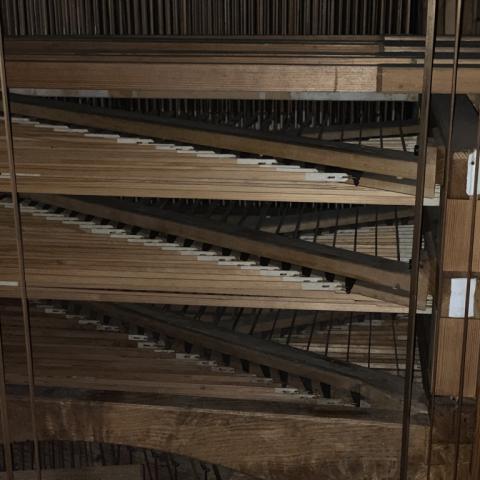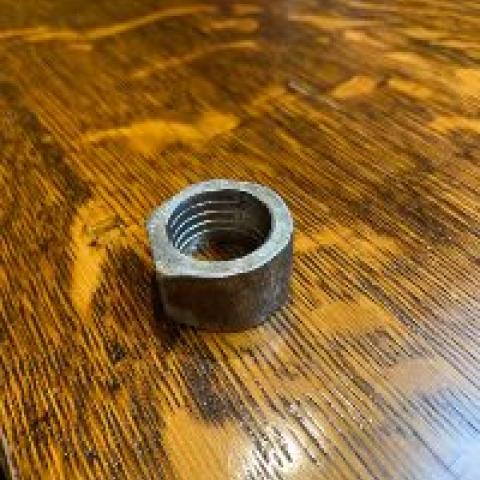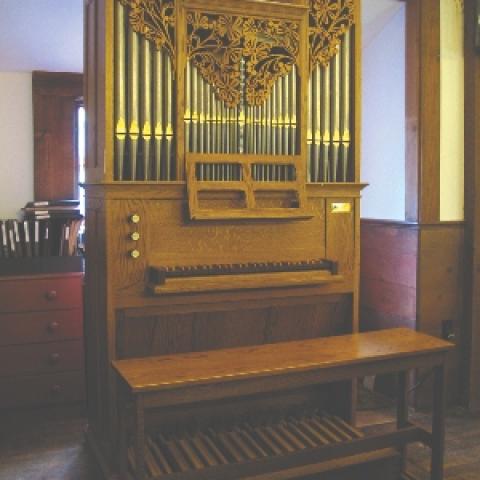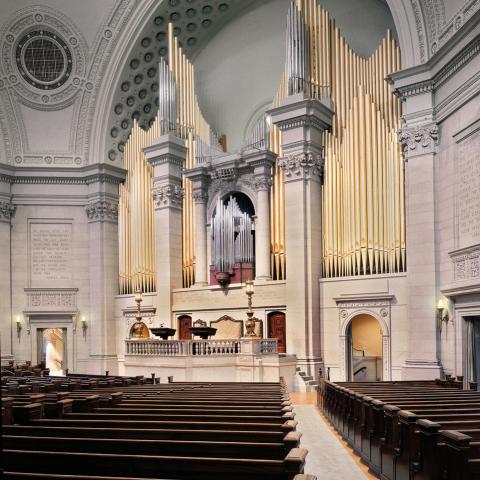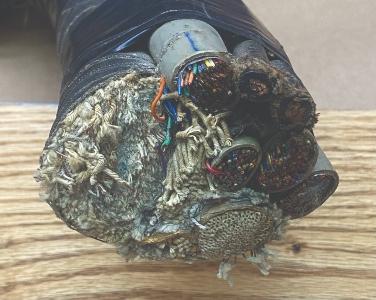
Everything’s under control.
It is early March, and there is two feet of snow on the ground in mid-coast Maine. Each foot came from a different storm. The bottom foot has a frozen crust making an awkward crunch halfway through. Farley the Goldendoodle’s legs are about twenty inches long, and he is just heavy enough to crunch the buried crust, so it is hard for him to do the things that dogs like (and need) to do outdoors.
It is overcast and snowing lightly now, and the wind is blowing frantic patterns in the water. We will be setting the clocks ahead this weekend, so it is about time to start thinking about the upcoming sailing season. On a sailboat, the sails are controlled by lines (they are never called ropes). Halyards raise and lower the sails, and sheets trim the sails in and out, adjusting their position relative to the wind. You might think that “sheet” refers to the sail, but you would be wrong.
Our sheet was new when the boat was built in 1999, and this was the winter to replace it. It is over a hundred feet long as it passes through a five-to-one ratio of blocks (pulleys) to provide the leverage needed to manage the large sail. I bought a beautiful piece of line, supple enough to manage all those turns without too much friction, and threaded it through the rig, ready for the first sail of the spring.
Besides halyards and sheets, all we need to control the boat (not counting the engine) is the steering gear that has a wheel, a rack-and-pinion gear system, and a rudder. That is called the helm, as in “Grandpa’s at the helm.” The more sails you have, the more lines and the more complex things seem. A large, square-rigged ship might have thirty or more sails, each with two sheets and two halyards, all running through countless blocks. It seems bewildering, but it is not nearly as many moving parts as a two-manual pipe organ with tracker action.
New-fangled
The introduction of electric actions in pipe organs around the turn of the twentieth century concerned organists who felt that electric actions would be slow and not as sensitive to the whims of the musician as the mechanical action that was in every organ until about 1890. I can make an argument for not being as sensitive—a well-built and carefully adjusted tracker action allows a special level of control that surpasses the on-off functions of electric contacts, but even the most intimate and sensitive of tracker actions commits the musician to playing a musical instrument by remote control.
A violinist cradles her instrument under her chin and generates tone with her touch of the bow against the strings. A clarinetist puts the instrument into his mouth and generates tone with the muscles inside his mouth coupled with air pressure from his lungs. It does not get any more intimate than that. The organist is either pulling on levers or flipping switches to control tone that is generated by a remote wind supply blowing through hundreds of static instruments, each of which can only play one note at one volume level. While a flutist can shape a phrase with intimate and intuitive breath control, for the organist any artistic nuance is achieved by purposefully operating a device—pulling on a stop, moving an expression pedal, changing keyboards. Altering the spacing and timing of notes and chords is about the only intuitive tool available.
With the development of electric actions, organ builders introduced innovations to give the organist more control over the instrument. I marvel especially at the first combination actions. Some were contained inside the organ console, such as those built by Casavant or Ernest Skinner’s stupendous vertical selectors, and others were remote, stacks of machines placed in adjacent rooms or basements, connected to the console by cables containing hundreds of conductors.
Think about a three-manual console with a hundred or more stop controls and a remote combination action. There are three sets of sixty-one wires and one of thirty-two for the keys and pedals. That is 215 wires leaving the console. Add forty pistons, and that is 255 wires. Add stop actions and on-off wires so pistons can operate the console’s many stop knobs, that is 555 wires. Add forty-eight for three sixteen-stage expression motors, add two for “bride signals.” You get the picture.
Think of all that multiplicity in the light of the four-manual, seventy-six-stop organ Mr. Skinner placed in Saint Thomas Church in New York City in 1913. It had seven pistons for each of five divisions (no generals), and a set button. That console and its related equipment was a commercially available, user-programmable binary computer built of wood, leather, and bits of metal built in Boston in 1913. I wonder if anyone still arrived at church on Sunday in a horse-drawn carriage in 1913?
Artifacts
I have a collection of trinkets that reminds me of past episodes that I have kept for decades in all the places we have lived. In a top bureau drawer in a little monogrammed leather box given to me by my godmother when I graduated from high school, I keep my draft card from 1974. (The draft call ended in December 1972, but eighteen-year-old men had to register until April 1, 1975.) On top of that bureau, I keep a mug with the logo of Bohemian Trucking in Las Vegas, filled with pens and pencils. Bohemian Trucking bailed the Organ Clearing House out of disaster at the last moment when a moving company abruptly canceled the five semi-trailers we had arranged to move the Möller organ, Opus 5819, from Philadelphia to the University of Oklahoma for the American Organ Institute. Bohemian stepped in on a day’s notice with those five trucks. They are out of business now, but the mug is a fun reminder of a very dynamic couple of days. I remember vividly the phone call from the moving company that stiffed us. I was waiting at a baggage carousel at the airport in Philadelphia, getting ready to load the organ the next day.
I am not proud remembering my very public, very angry reaction. I am sure I frightened some people.
One trinket that stands out usually lives on top of a bookcase in my office. It is an eighteen-inch chunk of the console cable from Trinity Church in Boston’s Copley Square. It includes cables from three generations of that organ all bundled into one: the original 1926 four-manual, sixty-one-rank Skinner Organ Company Opus 573 located in the rear gallery; Aeolian-Skinner Opus 573A, which was a new three-manual, fifty-rank organ installed in the chancel in 1956; and Aeolian-Skinner Opus 573-ABC, which was the 114-rank combination of both chancel and gallery organs finished in 1961. There were electro-pneumatic coupler actions in the console cabinet, but all the switching and relays that controlled pitman and unit windchests of the nine divisions, the combination action, and controls for accessories like tremolos and expression were in a basement room directly below the console. Eighteen inches of that cable weighs almost eight pounds. I do not remember all the details, but doing math as I did earlier for a mythical one-hundred-stop organ, this cable has somewhere between 1,400 and 1,500 conductors. It looks like more.
The 1926 cable was made by Skinner using white cotton-covered wire, wrapped in friction tape. (I like to call it hockey tape.) The second cable is again all white conductors, but it was commercially made as a cable with a woven cloth sheath. The newest one is something like what we use now, vinyl-clad cable with conductors insulated with color-coded PVC. Jason McKown, the old “Skinner Man” who maintained the Trinity organ for fifty years before me, told me that this was one of the first organs Aeolian-Skinner wired with color-coded cables, and the guy who did most of the wiring was colorblind so even with the color code, he did the wiring the old-fashioned way, ringing out each conductor separately. This artifact is my reminder of one of the more dramatic days in my career.
It was a hacksaw.
The double organ at Trinity Church has always been heavily used by brilliant organists who know how to give it a workout, and by around 1990 all the electro-pneumatic switching and combination actions in that basement room were wearing out. Phosphorous bronze contacts were breaking regularly, causing dead notes and cross ciphers as broken contacts fell inside the vertical switches causing clusters of notes to play simultaneously, a great way to annoy organists. There were also hundreds of switches in the chancel and gallery organ chambers in similar condition.
As I was curator of the organs, my Bishop Organ Company was engaged to install a solid-state control system. The whole process would be accomplished without the organ missing a Sunday or Friday noon recital. As I look back, I must have been nuts to agree to that, but I sure remember that the rector was not giving any ground. He was good at not giving ground. I worked with Brian Jones, the organist and director of music, to develop a scheme that involved buying a console for temporary use while the original console went to the workshop for renovation.
We built new stopjambs for the temporary console with layout identical to the originals, and wired all the keyboard, stop, piston, and expression outputs with new cables fitted with connectors. We pre-wired the hundreds of rows of switches in the remote room and chambers with new color-coded cables fitted with connectors, we hung the SSL control boards in all locations, and pre-wired all the inputs and outputs to and from those boards. With dozens of pitman and unit windchests, there were thousands of connections in the organ. There were more than 250 cables, each with a hundred conductors. Most of the rows were either sixty-one or seventy-three notes, so a lot of conductors were left over as spares, but you get the idea.
When every new connection had been made, all the connectors organized, and the organ was still playing on its original wiring, we brought the temporary console to the church. All six of us were ready when the 6:00 p.m. service ended that Sunday night. As the congregation was leaving, we fanned out across the building with our assignments. I gave myself the task (privilege?) of cutting that console cable. I used a hacksaw. It was breathtaking. I think it was the most thrilling and dreadful moment of my career. Two swipes of that saw blade and the organ was unplayable.
We dragged over forty feet of the old cable out of the conduit, more than a hundred pounds of copper wire, put the temporary console in place, ran the new cables through the conduit, and set about plugging in all those cable connectors. As each seventy-three-note switch was plugged in, the original organ wiring had to be cut away, and old and new wires had to be wrapped and dressed to keep the job neat. Working against the deadline of the Friday recital (would the organist have any time to practice?), we were ready to turn the organ on by Wednesday morning and play it from the new console. Every organ builder knows the rush of feelings when you turn that switch for the first time.
It played.
It was not perfect, but it played. SSL systems had an odd configuration with stop action and key action on opposite polarities of the organ’s direct current. In the original Skinner and Aeolian-Skinner wiring, all functions of the organ operated with positive “on” impulses and negative commons. SSL had the stop actions with negative “on” and positive grounds, so our preparation had to include running positive commons to all the stop actions, and during the switchover week we had to separate the stop action commons from those on key actions. We had the polarities of the stages of expression motors wrong. The first time we tried to operate an expression pedal, we blew a row of transistors. It was lucky that in those days we still had neighborhood Radio Shack stores and could quickly buy new transistors and solder them to the SSL boards. It cost just a few dollars, a few hours, and a big helping of anguish.
The conductors inside all those cables are arranged in groups of ten, each with a solid color and a “stripey” color—white with blue stripe, blue with white stripe, white with orange, orange with white, white with green, etc. Blue, orange, green, brown, slate repeats with group colors. When you finish those five pairs with white, you move to red with blue, etc., then black with blue, etc., then yellow with blue, etc., then violet with blue, blue with violet—groups of ten with white, red, black, yellow, violet. The first fifty wires are wrapped with blue, then you start over with white with blue. The pattern can be infinite. The point is that you can wire each end of the cable by yourself according to the code, rather than the old way requiring two people using a buzzer or a light to find the opposite ends of each wire.
All the pre-wiring on the temporary console, the remote room, inputs for each keyboard and stop to the SSL boards, and outputs from the boards to each of the hundreds of switches to the windchests was done by two of my employees. We generally used 32-pair cables that are specially made for pipe organs as they have enough conductors for sixty-one notes plus three spares, but since many (most?) of the windchests and ranks in the Trinity organ have seventy-three (super-coupler extensions) or more notes, we used 50-pair cable throughout the instrument. In 32-pair cable, the code goes only as far as yellow with blue, blue with yellow, the thirty-first and thirty-second conductors, then starts over with white with blue. The 50-pair cable goes through all fifty color combinations before starting over. I bother to explain that because those two people who were my wiring wizards were less used to 50-pair cables, and it turned out that one of them could not tell between the violet/blue–blue/violet pair, notes 41 and 42, the “E” and “F” above “soprano C.”
I sent the team across the organ double-checking and correcting those two conductors wherever they were reversed. We spent Wednesday and Thursday correcting the glitches. The recitalist practiced on Thursday night, and like every Friday morning during my tenure there, I tuned reeds until 10:00, the recitalist warmed up, and the audience arrived.
The rest was simple. We renovated the original console with electric drawknob motors, pre-wired it now that we were so good at it, brought it back to the church, and plugged it in. Plug-and-play for an organ with nine divisions. It took less than a day including the round-trip drive from the workshop twenty-five miles away.
I do not have an accurate count of how many conductors there are in that organ, how many violet/blue pairs were reversed, or how many transistors burned. I do not remember how late we worked into each evening. I sure do remember kneeling behind that console at 7:30 on a Sunday evening with a hacksaw in my hand, drawing breath, and hacking away. I was in my mid-thirties. I guess I thought I knew a lot. I had a few moments that week when I smelled smoke. I am sure I had moments that week when I smelled disaster. I know how pleased we all were when the organ played from the first moment the blower was on. Brian was congratulatory, and I never heard a word from the rector.
Didn’t miss a Sunday.


